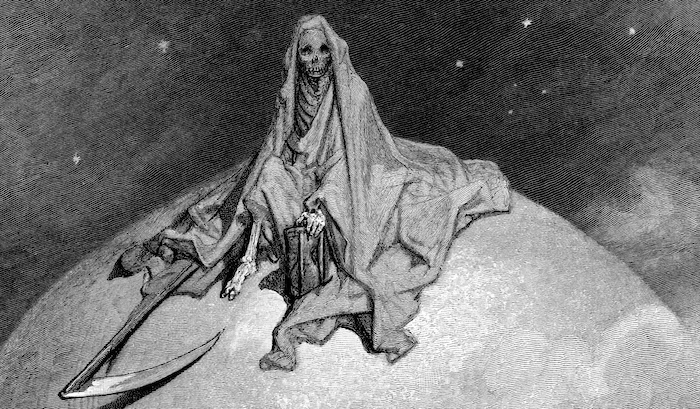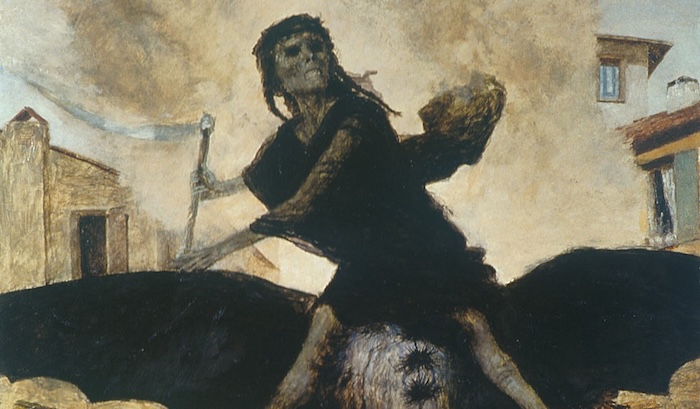Death’s Godson is a fairy tale found in different versions throughout much of the historically-Christian parts of the world. It’s number 332 in the Aarne-Thompson classification, and a version of it is #44 if the Brothers Grimm. At the climax of the story, the world changes so no one is able to die, and no one knows why, nor do they know that the situation is not permanent. If you have the first part of Death’s Godson occur offscreen in your ongoing fantasy campaign, it can serve as an adventure hook as the party involves themselves in the story while trying to figure out why no one is dying—or a springboard to your PCs generating their own adventures as they try to exploit this new state of affairs, perhaps to their own downfall when death returns to the world at the worst moment …
Death’s Godson is a fairy tale found in different versions throughout much of the historically-Christian parts of the world. It’s number 332 in the Aarne-Thompson classification, and a version of it is #44 if the Brothers Grimm. At the climax of the story, the world changes so no one is able to die, and no one knows why, nor do they know that the situation is not permanent. If you have the first part of Death’s Godson occur offscreen in your ongoing fantasy campaign, it can serve as an adventure hook as the party involves themselves in the story while trying to figure out why no one is dying—or a springboard to your PCs generating their own adventures as they try to exploit this new state of affairs, perhaps to their own downfall when death returns to the world at the worst moment for them.
Though versions of Death’s Godson have been collected as far afield as Iceland, Armenia, and Brazil (though only in communities that do baptism and godparents, as you’ll see in a moment), I’ll be primarily using a version collected around 1880 in Aude, on the slopes of the Pyrenees in southern France.
This post is brought to you by beloved Patreon backer Joel Dalenberg. Thanks, Joel—you rock!
 Detail from The Raven by Gustav Doré, 1883
Detail from The Raven by Gustav Doré, 1883
A poor couple with five children, whom they are barely able to feed, gave birth to yet another baby. Thus they named it John-Too-Much (Jean-le-Trop in the Romance language Occitan). How would they afford to throw a feast when they baptized their child? Who would agree to be the godparents of a child likely to need so much? Yet the couple had an ace in the hole they didn’t know about. The husband once gave a crust of bread to a beggar, and that beggar was actually Jesus Christ on an incognito walkabout. The beggar volunteered to be John-Too-Much’s godfather and promised to produce a godmother.
On the day of the baptism, the beggar appeared with four donkeys laden with food and drink for a feast to celebrate John-Too-Much’s baptism. The neighbors, who weren’t willing to help before, were happy to help make the food and drink disappear. Then John-Too-Much’s promised godmother appeared in a carriage. When the carriage door opened, she was revealed as Death herself: a skeleton of bleached white bone. The neighbors fled, but Death blessed the family. She told each relative she’d ensure they lived two hundred years and she would teach John-Too-Much a trade to ensure he prospered.
Note that death in this version is female, consistent with the gendered noun la mort. In other versions, especially in gendered languages where the word for death is masculine, Death is the godfather, and Jesus isn’t involved. In Franconian German, the whole story is a pun, as der tod can mean both “death” and “godfather.” There has been speculation that this pun may be the original source of the fairy tale, which then spread to other languages, but I tend to be skeptical of cute etymological explanations for things that didn’t really need explaining.
 Detail from The Plague by Arnold Böcklin (1898)
Detail from The Plague by Arnold Böcklin (1898)
When John-Too-Much came of age, Death taught him to be physician. He visited the sick. Death was always in the room with them, invisible to everyone except John-Too-Much. If Death stood at the head of the bed, the patient would die. John-Too-Much would shake his head and send for a priest. If Death stood at the foot of the bed, the patient would live. John-Too-Much would “treat” the patient with a few drops of harmless licorice water, then took the credit for the patient’s eventual recovery. John developed a great reputation for his cures that, when administered, always worked.
When the king’s daughter fell sick, the king sent for John-Too-Much. The wily physician saw that his godmother stood at the foot of the princess’s bed: she would live. He told the king he would save the princess’s life in exchange for her hand in marriage. John-Too-Much was young and handsome and the princess agreed to the deal. She recovered and they were married.
But John had been promised 200 years of life, while the princess had not. He wanted his godmother to extend the life of his bride. Death refused. So John decided to trick his godmother. He accused her of not being powerful enough to extend his bride’s life: “Why, I bet you couldn’t even fit inside this bottle, you’re so powerless.” This is a fairy tale, so of course Death proved him wrong by shrinking and entering the bottle, and of course John-Too-Much stoppered the bottle with Death inside. He said he wouldn’t let Death out until his godmother gave the princess as long a life as his.
For a week, Death was trapped inside the bottle. And for a week, no one died. Everyone was astonished—most of all the Devil, whose supply of damned souls was cut off. Eventually, Death acceded to John-Too-Much’s wishes, and he let her out of the bottle.
This version of the story ends happily, but not all do. In some, Death takes her revenge. She leads her godson into a cave full of lanterns and lights and matches. She shows the hero his own “light of life,” which is about to go out. Then she wrings his neck.
 In your ongoing fantasy campaign, the party might be down in a dungeon or otherwise engaging in fantasy violence, when one of the intelligent humanoids the party slays doesn’t die. Oh sure, it’s in agony, its body writhing in the center of the room while its severed head screams bloody murder in the corner. But it doesn’t actually die, for a moment ago your version of John-Too-Much trapped Death in a bottle. How does the party react to this, and what do the PCs feel they owe to their vanquished, agonized, and decidedly not-dead (but not undead) foes?
In your ongoing fantasy campaign, the party might be down in a dungeon or otherwise engaging in fantasy violence, when one of the intelligent humanoids the party slays doesn’t die. Oh sure, it’s in agony, its body writhing in the center of the room while its severed head screams bloody murder in the corner. But it doesn’t actually die, for a moment ago your version of John-Too-Much trapped Death in a bottle. How does the party react to this, and what do the PCs feel they owe to their vanquished, agonized, and decidedly not-dead (but not undead) foes?
The next time the PCs enter a town or village, they find no one is dying. People run over by carts are still walking around, trying to do their jobs as best they can. People on their deathbeds aren’t shuffling off this mortal coil. When it’s clear that this is not a localized phenomenon, the PCs need to decide whether they’re going to try to investigate this mystery, whether they’re going to find a clever way to exploit it, both, or neither.
For the purposes of clever exploitation, you’ll need to decide what Death being stoppered means for your fictional setting. Do slaughtered livestock keep going (with your pork pie dancing a jig in your stomach), or is the effect limited to intelligent beings? Does Death (or perhaps this particular Death) only collect folks of a particular religion, ancestry, geographical region, or plane of existence? What happens to someone whose body is utterly destroyed by fire, acid, or a disintegrate spell? How does it affect the undead? I don’t think the actual answers to these questions matter a huge amount as long as they are consistent with the cosmology of your fictional setting and are consistently applied at the table. As long as the rules are consistent, the PCs can learn them through trial and error, then come up with some clever scheme to exploit them. At your discretion, John-Too-Much might unstopper Death at exactly the moment that will cause the most trouble for your party.
If the PCs want to figure out why no one dies anymore, their questions can lead them to a former neighbor of John-Too-Much—a dying woman who claims she saw Death some twenty years ago at John-Too-Much’s christening. Perhaps she thinks a deathbed confession of her unneighborly behavior towards John’s parents will free her to continue on. It won’t. But her story about Death being the godmother of the famous physician John-Too-Much can set the party on his track, leading them to the king’s castle, John-Too-Much, and his stoppered bottle that contains Death.
What the PCs do with the bottle is their business. But don’t forget the version of the story where Death takes her revenge on John-Too-Much. If the party could have freed her but didn’t, they may make an enemy of the most dangerous being of all.
 Illustration from Brothers Grimm tale 44, Godfather Death (Der Gevatter Tod)
Illustration from Brothers Grimm tale 44, Godfather Death (Der Gevatter Tod)
Make sure you don’t miss a blog post by subscribing to my no-frills, every-other-week mailing list! I also have a signup that’s only for big product releases!
Looking for material for your game tonight? My back catalog has hundreds of great posts, all searchable and filterable so you can find something from real history or folklore that fits exactly what you need!
Come follow and chat with me on social media! On Bluesky, I’m @moltensulfur.bsky.social. On Mastodon I’m @MoltenSulfur@dice.camp.
Sing and fight magical folk ballads in 1813 England and Scotland! This free early-access edition has everything you need to play a Ballad Huntersone-shot about the traditional song Barbara Allen.
The game has: – Investigative adventures centered around the lyrics of traditional British ballads – Simple, story-driven rules inspired by the GUMSHOE engine – A historical setting that is grim but hopeful – Magic where characters make ballad verses come to life
Ballad Hunters is the sequel to Shanty Hunters, winner of a 2022 Ennie Award (Judge’s Choice) and nominee at the Indie Groundbreaker Awards for Most Innovative and Game of the Year.
You can download the free early-access version of the game from DriveThruRPG or Google Drive.
The final game will be published by Pelgrane Press, the people behind 13th Age and GUMSHOE games like Trail of Cthulhu, Swords of the Serpentine, and The Yellow King. You can read more about it on their website and sign up to be notified when it’s available for purchase by putting yourself on my mailing list.
**Source:**Love, Death, and Money in the Pays d’Oc by Emmanuel Le Roy Ladurie (1980)